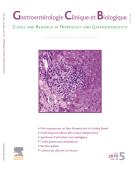Risk factors and long-term course of thyroid dysfunction during antiviral treatments in 221 patients with chronic hepatitis C - 29/02/08
Xavier MoncouCy [1],
Florence Leymarie [4],
Brigitte Delemer [2],
Stéphane LÉvy [1],
Brigitte Bernard-Chabert [1],
Olivier BouchÉ [1],
Damien Jolly [4],
Marie-Danièle Diebold [3],
Guillaume Cadiot [1],
Gérard ThiÉfin [1]
Mostrare le affiliazioniFacteurs de risque et évolution à long terme de la dysthyroïdie survenant lors d'un traitement antiviral chez 221 malades traités pour hépatite chronique C |
Objectif |
Identifier les facteurs prédictifs de survenue d'une dysthyroïdie lors du traitement de l'hépatite chronique C et évaluer sa prise en charge à long terme.
Méthodes |
Tous les malades traités pour hépatite chronique C entre 1990 et 2001 ont été analysés de façon rétrospective. Les malades ayant des antécédents thyroïdiens, infectés par le virus de l'hépatite B ou le virus de l'immunodéficience humaine étaient exclus. Une dysthyroïdie était définie par un dosage sérique anormal de la TSH contrôlé à deux reprises.
Résultats |
221 malades consécutifs ont été inclus. Parmi eux, 100 avaient été traités au moins deux fois par interféron alpha, 21 au moins trois fois et 3 avaient été traités quatre fois. Quinze de ces malades (7 %) ont présenté une dysthyroidie. La fréquence des dysthyroïdies lors du premier traitement n'était pas différente de celle observée lors d'un deuxième traitement [respectivement 4,1 % (N = 9) et 6 % (N = 6)]. Le sexe féminin et la présence d'anticorps anti-microsomes ou anti-thyroperoxydase (anti-TPO) avant le traitement antiviral étaient des facteurs prédictifs de la survenue d'une dysthyroïdie. Le risque de dysthyroïdie n'était pas différent sous monothérapie par interféron alpha et sous bithérapie par interféron alpha et ribavirine. Il n'était pas aggravé par l'interféron pégylé sous réserve du nombre limité de traitements de ce type (N = 49). Treize malades ont eu une hypothyroïdie (2 résultaient d'une thyroïdite biphasique) et deux une hyperthyroïdie. Le traitement antiviral a été poursuivi chez 11 malades. Sept des 13 malades hypothyroïdiens ont nécessité une opothérapie au long cours avec un recul de 15 à 90 mois.
Conclusion |
Dans notre série, 7 % des malades atteints d'hépatite chronique C ont présenté une dysthyroïdie lors d'un traitement antiviral. Le risque était plus élevé chez les femmes et en présence d'anticorps anti-microsomes ou anti-TPO avant traitement. Il n'était pas aggravé par la bithérapie. L'absence de dysthyroïdie lors d'un premier traitement antiviral ne préjugeait pas du risque de dysthyroïdie lors d'un deuxième traitement.
Aim |
To identify the predictive factors of dysthyroidism during treatment for chronic viral hepatitis C and to evaluate the long-term outcome of these patients.
Methods |
Patients treated for chronic viral hepatitis C between 1990 and 2001 were analyzed retrospectively. Patients with dysthyroidism before treatment and patients positive for hepatitis B surface antigen or human immunodeficiency virus antibodies were excluded. Dysthyroidism was defined by an abnormal serum TSH level on two separate occasions.
Results |
221 consecutive patients were included. Among them, a hundred were treated twice by interferon alpha, 21 had 3 treatments and 3 had 4 treatments. Fifteen of these patients (7%) had dysthyroidism during antiviral therapy. There was no significant difference in the frequency of dysthyroidism during the first and the second treatment [respectively 4,1% (N = 9) and 6% (N = 6)]. Female gender and the presence of antimicrosome or antithyroperoxydase (anti-TPO) antibodies before antiviral treatment were predictive factors of dysthyroidism. Treatment by interferon and ribavirin did not increase the risk of dysthyroidism compared to monotherapy with interferon. Pegylated interferon (N = 49) was not a risk factor compared to standard interferon. Thirteen patients had hypothyroidism (2 of them as a result of biphasic thyroiditis) and 2 had hyperthyroidism. The antiviral treatment was continued in 11 patients. Seven out of 13 patients with hypothyroidism required an indefinite treatment (follow-up: 15 to 90 months).
Conclusions |
In our series, 7% of patients with chronic viral hepatitis C had a dysthyroidism during antiviral therapy. Predictive factors were female gender and positive antimicrosome or anti-TPO antibodies before treatment. Absence of dysthyroidism during a first antiviral treatment did not preclude from the risk of dysthyroidism during a second treatment.
Mappa
© 2005 Elsevier Masson SAS. Tous droits réservés.
Vol 29 - N° 4
P. 339-345 - Aprile 2005 Ritorno al numeroBenvenuto su EM|consulte, il riferimento dei professionisti della salute.

